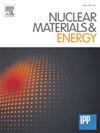比较 DIII-D SAS 和 SAS-VW 分流器能量耗散的实验-模型研究
IF 2.7
2区 物理与天体物理
Q1 NUCLEAR SCIENCE & TECHNOLOGY
引用次数: 0
摘要
最近对小角槽(SAS)导流器进行的DIII-D实验证实,导流器闭合和靶形的结合可以增强导流器靶的冷却并增加能量耗散,但对BT(环向磁场)方向有很大的依赖性。在这些新型分流器中,闭合、靶形、漂移和尺度长度在优化耗散中的作用都是相互关联的,而分离矩阵电子密度neSEP是与耗散/分离水平相关的关键参数。在对原始的平面靶石墨SAS进行修改后,在转向器的外侧加入了一个带有钨涂层的V形(SAS- vw),并运行了一系列匹配的放电,以与详细的SOLPS-ITER模型进行比较。在实验中,当SAS- vw的外击点位于狭缝顶点时,SAS- vw对分离的neSEP要求与原始SAS几乎相同,而新几何结构的耗散差异很小。这与(1)早期的建模预测相反,即对于具有更好的h模式进入(离子B ×∇B漂移直接进入分流器)的磁性配置,SAS几何形状的微小变化应该增强相同neSEP下的耗散,并且(2)尽管在SAS- vw槽中实现了显着更高(2-7x)的中性压力和压缩。将实验密度扫描与最近使用ExB漂移的SOLPS-ITER模型的比较表明,当使用分离矩阵密度作为独立参数时,耗散/脱离开始的情况是合理的。为了帮助理解新配置的模型与实际性能的差异,进行了不同气体注入位置和杂质注入的额外测量。槽内D2气体加注对分离的促进作用更大(5 - 22%),与模型一致。槽内杂质注入(N2或Ne)可以使岩心Zeff降低30%,分离后的限制降解减少15%,并且从分流器中泄漏的钨相对较少。建模还可以再现改进的脱离,因为打击点移动到槽顶点的内侧。虽然我们可以解释导致这些槽分流器能量耗散的最重要参数的影响,但它们的行为的许多方面仍然无法使用最先进的代码(如SOLPS-ITER)精确建模。这是未来使用类似v形几何形状的模型驱动设计所关注的。本文章由计算机程序翻译,如有差异,请以英文原文为准。
Experiment-modeling studies comparing energy dissipation in the DIII-D SAS and SAS-VW divertors
Recent DIII-D experiments on Small Angle Slot (SAS) divertors have confirmed that a combination of divertor closure and target shaping can enhance cooling across the divertor target and increase energy dissipation, but with significant dependence on BT (toroidal magnetic field) direction. In these novel divertors, the roles of closure, target shaping, drifts, and scale lengths are all interconnected in optimizing dissipation, with the separatrix electron density neSEP being the key parameter associated with the level of dissipation/detachment. After modifying the original flat-targeted graphite SAS to include a V shape with a tungsten coating on the outer side of the divertor (SAS-VW), matched series of discharges were run to compare to detailed SOLPS-ITER modeling. Experimentally, when run as designed with the outer strike point at the slot vertex, SAS-VW requires nearly identical neSEP for detachment as the original SAS, with little difference in dissipation for the new geometry. This is in contrast to (1) earlier modeling predictions that a small change of the SAS geometry to a V shape should enhance dissipation at the same neSEP for magnetic configurations having better H-mode access (ion B × ∇B drift directed into the divertor), and (2) despite the achievement of significantly higher (2-7x) neutral pressures and compression in the SAS-VW slot. Comparisons of experimental density scans to the most recent SOLPS-ITER modeling with ExB drifts show reasonable agreement for dissipation/detachment onset when using separatrix density as the independent parameter. In order to help understand the discrepancy in modeled vs actual performance for the new configuration, additional measurements varying gas injection location and impurity injection were undertaken. In-slot D2 gas fueling is more effective (5–22 %) in promoting detachment, in accord with modeling. In-slot impurity injection (N2 or Ne) can yield 30 % lower core Zeff and 15 % less confinement degradation after detachment compared to main chamber puffing, as well as relatively lower tungsten leakage from the divertor. Modeling can also reproduce the improved detachment seen as the strike point moves inboard of the slot vertex.
While we can explain the effects of the most important parameters causing energy dissipation in these slot divertors, it remains that many aspects of their behavior cannot be accurately modeled using state-of-art codes such as SOLPS-ITER. This is of concern for future model-driven designs utilizing similar V-shaped geometries.
求助全文
通过发布文献求助,成功后即可免费获取论文全文。
去求助
来源期刊

Nuclear Materials and Energy
Materials Science-Materials Science (miscellaneous)
CiteScore
3.70
自引率
15.40%
发文量
175
审稿时长
20 weeks
期刊介绍:
The open-access journal Nuclear Materials and Energy is devoted to the growing field of research for material application in the production of nuclear energy. Nuclear Materials and Energy publishes original research articles of up to 6 pages in length.
 求助内容:
求助内容: 应助结果提醒方式:
应助结果提醒方式:


